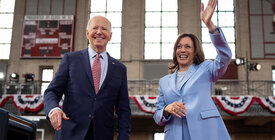
Arizona Races Funded by National Donors
Candidates in Arizona are relying heavily on national donors and super PACs, weakening constituents’ influence.

Part of
Arizona’s congressional elections highlight key trends in modern campaign financing as well as any state. Candidates are relying on national donors to fund their campaigns: An estimated 74 percent of all Arizona congressional candidates’ campaign contributions this cycle have come from out-of-state or out-of-district donors, up from about half in 2010. National groups with no meaningful ties to Arizona are dominating independent expenditures as well, including groups from the cryptocurrency industry that are wading deeper into politics, and the presence of untraceable “dark money” means the problem is likely even worse.
In Arizona, these issues also intersect with election denial as some candidates embrace the Big Lie of a “stolen” 2020 election and rely heavily on a national pool of non-constituent donors.
Candidates rely on donors who aren’t their constituents
Like the races we profiled in Pennsylvania and Ohio, candidates in Arizona are relying overwhelmingly on money from non-constituents. Of the $72.7 million that Arizona’s House and Senate candidates raised through June 30, we estimate that nearly three-quarters came from donors who live outside the state (for Senate candidates) or outside candidates’ districts (for House races).
This trend cuts across party lines for all types of candidates, whether incumbents, challengers, primary winners, or losers. Among House candidates who raised at least $100,000, we estimate that three brought in more than 90 percent from outside their districts — Republicans Blake Masters, Abe Hamadeh, and Eli Crane. Seven others — Republicans Paul Gosar, Kelly Cooper, and Andy Biggs, and Democrats Greg Stanton, Greg Whitten, Andrei Cherny, and Raúl Grijalva — raised more than 80 percent of their money from out-of-district donors. The major Senate candidates, Republican Kari Lake and Democrat Ruben Gallego, relied slightly more on constituents, but they still raised most of their money from non-Arizonans — 70 percent for Lake and 75 percent for Gallego.
The proportion of non-constituent fundraising in Arizona today is significantly higher than a decade ago. In 2010, candidates raised only about half of their money — 54 percent — from non-constituents through the end of June of the election year. The portion has risen since, peaking at 83 percent in the 2022 midterms. While fundraising this cycle has not yet reached that level, it may rise as donations from around the country continue to flood into high-profile races closer to Election Day.
These figures are a stark example of how nationalized the funding of congressional campaigns has become. This is a problem because as candidates increasingly rely on money from donors who are not their constituents, it causes increased pressure for them to cater to a national donor class rather than the needs of their districts.
Election denial
Election deniers are some of the most reliant on out-of-state and out-of-district money among Arizona’s congressional candidates. Since the state’s pivotal role in the last presidential election, Arizona has been a hotbed of election denial, featuring fake electors, a partisan sham “audit” of the vote, and a slate of (unsuccessful) election-denying candidates in 2022 statewide races. Several election deniers have advanced to the general election this year, as well.
One of those is Hamadeh, who won a competitive primary in the Eighth District. He has pushed the Big Lie following his failed run for state attorney general in 2022 and subsequent lawsuit to overturn his loss. In this year’s primary, Hamadeh beat Toma and tech venture capitalist Masters, who also invoked election denial in his 2022 campaign for Senate. Hamadeh was a strong national fundraiser, taking in almost $1 million, with an estimated 96 percent from outside his district. But he was outspent two-to-one by Masters, who loaned his own campaign $3.5 million (and raised almost nothing from donors in the district).
Crane, the incumbent GOP nominee for the Second Congressional District, won his seat in 2022 touting election conspiracies. He was one of the Republicans who initially voted to block Republican Kevin McCarthy from becoming speaker and to oust him months later. Despite running in a safely red district, Crane has raised a huge sum, more than $5.4 million, with an estimated 95 percent from outside the district.
To be sure, not all election deniers have relied so much on national donors. Lake’s 2022 gubernatorial bid relied heavily on election denial, and she refused to acknowledge her loss and challenged the result in court. Her claims that the election was stolen from her initially proved lucrative — her campaign raised $2.5 million in the weeks after Election Day. But her Senate campaign has not brought in as much from national donors compared to other candidates, perhaps due to the same factors that have caused her to struggle with fundraising generally. Lake has been massively outraised this cycle by Gallego, who has hauled in $29.9 million compared to her $8.7 million. Independent expenditures have also overwhelmingly been in Gallego’s favor, with 74 percent of the $31.7 million spent so far boosting him or attacking Lake.
Big spending by national groups
Independent expenditures, which come predominantly from national groups that have no meaningful ties to Arizona, have further entrenched the trend of nationalization.
In the Senate race, for example, where independent expenditure groups have already spent $31.7 million, the top spenders are all national groups funded by national donors. Protect Progress and WinSenate PAC, the biggest spenders in the race so far, are funded by the cryptocurrency industry and a national pro-Democrat super PAC, respectively. The largest Republican-aligned spending group and third largest overall, Win It Back PAC, has reported no donors in Arizona and similarly receives almost all its funding from national conversative groups like Club for Growth Action.
The same is true of the House race with the most independent expenditures, the Democratic primary for the Third Congressional District left open by Gallego’s Senate run. Independent expenditure groups poured $5.3 million — twice as much as the campaigns themselves — into this extremely close race, which Yassamin Ansari won by just 39 votes. The independent expenditures split roughly equally between Ansari and her opponent, Raquel Teran, but the largest spending by far came from Protect Progress, which spent $1.4 million supporting Ansari (in addition to $7.6 million boosting Gallego’s Senate run). The next highest spender in the Third District, Democratic Majority for Israel, spent $644,000, split between both candidates.
Dark money spending
Groups that don’t disclose their donors have spent millions more in Arizona’s elections supporting candidates from both parties.
On the Democratic side, LCV Victory Fund, a super PAC funded in part by the League of Conservation Voters, which does not disclose all its donors, spent $2.8 million supporting Democrats candidates, with the lion’s share boosting Gallego’s run for Senate. Another group, Somos Votantes, has spent $746,000 supporting Gallego through an affiliated PAC whose funds come primarily from two New Hampshire–based organizations.
On the Republican side, National Interest Action spent nearly $1 million supporting Arizona state house Speaker Ben Toma’s unsuccessful bid in the GOP primary for the Eighth Congressional District. This group has not yet filed full disclosures with the FEC. While it may end up disclosing its donors, the source of its funding was a mystery at the time of the primary. The Kansas-based Koch network’s Americans for Prosperity Action also spent more than $780,000 thus far across several races to boost Toma and other GOP candidates.
• • •
Millions of dollars are flowing into Arizona’s congressional elections from outside the state and outside candidates’ districts, in extreme cases to further baseless conspiracy theories and election denial. To be sure, national donors’ policy agendas may align with those of voters in the state. But the dominance of national money creates the risk that, once elected, officials are more responsive to wealthy national donors than the constituents they’re supposed to serve.
This analysis used campaign finance data from the FEC, processed by Eric Manning and Open Secrets.
Methodology
The Brennan Center’s analysis compares contributions reported by candidates’ campaign committees with transactions reported by the fundraising conduits ActBlue and WinRed. Campaign committees report donations as itemized contributions when the contributor has given more than $200 to the candidate within the election cycle and as aggregated unitemized totals for smaller amounts. The fundraising conduits report transactions as itemized contributions regardless of amount. By comparing these reports, eliminating duplicate transactions, and identifying repeat contributors to the same candidate within the same cycle, we gain insight into the source of campaigns’ unitemized totals.
However, there remains a pool of “unknown” unitemized money that does not flow through the conduits, about which we do not know the donations’ timing, size, or source. We estimate the proportions of this pool of money contributed by small, medium, and large donors based on the observed overall proportion of known unitemized contributions coming from small, medium, and large contributors across all races for the same chamber within the same election cycle. This yields a “best-guess” estimate of how much unknown unitemized money comes from small, medium, and large donors. To assess the proportion of money that candidates raise from within their district or state, we rely on the zip codes or states disclosed by campaigns and conduits. For House races, if the donor’s zip code overlaps with the candidate’s district, we counted their contribution as in-district. A small number of transactions lack a valid zip code or state; for these transactions, we estimate that the proportions of in-state, out-of-state, in-district, and out-of-district money are equal to the proportions observed among the candidate’s total fundraising from sources with a valid zip code or state.
More from the Money in the 2024 Election series
-
We Don’t Have to Let Big Tech Money Dominate Elections
Weak campaign finance rules give an outsize voice to the ultrarich, but reforms can help. -
Out-of-State Money Fuels Expensive Elections in Pennsylvania
Pennsylvania’s federal elections are poised to be some of the most expensive races as big donors and national groups seek to shape the state’s congressional delegation. -
Can Harris Use Biden’s Campaign Money?
Long-standing FEC practice indicates Harris has a clear path to the funds.





